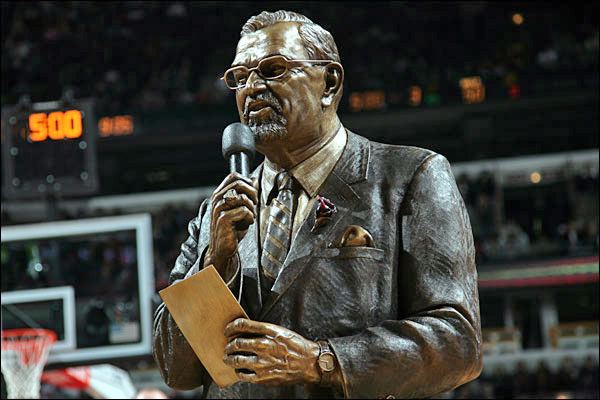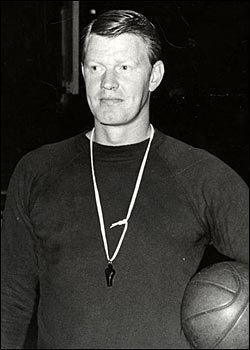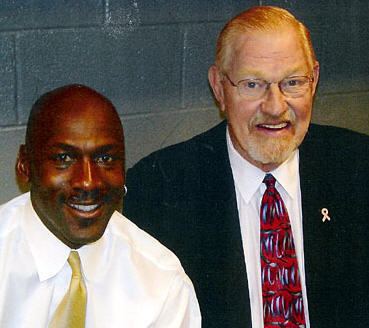Nationality American Name Johnny Kerr Listed height 6 ft 9 in (2.06 m) Role Basketball player | Listed weight 230 lb (104 kg) Weight 104 kg | |
 | ||
Born July 17, 1932Chicago, Illinois ( 1932-07-17 ) NBA draft 1954 / Round: 1 / Pick: 6th overall Spouse Betty Nemecek (m. 1954–2000) Education University of Illinois at Urbana–Champaign Awards | ||
Johnny kerr comes prepared for jordan s powder clap
John Graham "Red" Kerr (July 17, 1932 – February 26, 2009) was an American basketball player, coach, and color commentator. He played in the NBA from 1954 to 1966, mainly as a member of the Syracuse Nationals. He later held several coaching and administrative positions before embarking on a thirty-three year career as a television color commentator for the Chicago Bulls.
Contents
- Johnny kerr comes prepared for jordan s powder clap
- Johnny Kerr
- Playing career
- Coaching career
- Broadcasting career
- References

Johnny Kerr
Playing career

Although Johnny Kerr's first passion was soccer, an eight-inch growth spurt during his senior year at Tilden Technical High School compelled him to turn his attention to basketball. The 6' 9" center soon led his school's basketball team to the 1950 Chicago Public League Championship. After high school, he attended the University of Illinois, where he scored 1,299 points during his three years with the school's varsity team. The highlight of his collegiate career occurred in 1952, when he helped the Fighting Illini win the Big Ten Championship and advance to the NCAA Final Four. He was elected to the University of Illinois' "All-Century Team" in 2004.

In 1954, the Syracuse Nationals selected Johnny Kerr with the sixth overall pick of the NBA draft. During his first season (1954–1955), Kerr averaged 10.5 points and 6.6 rebounds and helped the Nationals capture their first NBA Championship. He became a three time All-Star (1956, 1959, 1963) with the Nationals, despite playing in the shadow of future Hall-of–Famer Dolph Schayes.

In 1963, the Nationals relocated to Philadelphia and became known as the 76ers. Two years later, Kerr was traded to the Baltimore Bullets for Wali Jones. After averaging 11.0 points and 8.3 rebounds for the Bullets during the 1965–1966 season, Kerr was selected by the Chicago Bulls in the 1966 NBA Expansion Draft. However, Kerr voluntarily retired so that he could become the coach of his hometown's new basketball team. He ended his career on November 4, 1965 with a 108–107 loss to New York, with respectable totals of 12,480 points and 10,092 rebounds, along with the NBA record for most consecutive games played (844) until 1983 when he was surpassed by Randy Smith.
Coaching career
Kerr is credited with bringing Jerry Sloan to the Chicago Bulls. The team went 33-48 in 1966–1967 and became the first expansion team to win a playoff berth in its inaugural season. For this accomplishment, Kerr was rewarded the NBA Coach of the Year Award. He is also the only coach to receive this award after his team finished with a losing record. The Bulls went 29-53 the following season, rallying from a 1-15 start to earn another playoff berth. However, feuds with team owner Dick Klein forced Kerr to leave the Bulls during the summer of 1968 and sign with the Phoenix Suns, another expansion team in need of its first coach. Unfortunately, the Suns finished with a 16-66 record in 1968–1969, and after starting the 1969–1970 season with a 15-23 record, Kerr was forced to resign.
Broadcasting career
Despite resigning as coach, Kerr stayed with the Suns franchise for the remainder of the 1969–1970 season, working as a broadcaster with Hot Rod Hundley. He spent the next two seasons as a business manager with the ABA's Virginia Squires, then returned to the Chicago Bulls to work in their front office. In 1975, the Bulls' play-by-play announcer, Jim Durham, suggested that Kerr provide commentary during games, and Kerr remained as a color commentator until the end of the 2007–08 season.
As a broadcaster, Kerr oversaw the Bulls' six championships in the 1990s and Michael Jordan's entire career with the team. He was known for making the call on "The Shot", Jordan's series-winning basket in Game 5 of the first round of the 1989 Eastern Conference Playoffs. Over the years, Kerr and Jordan developed a pre-game ritual in which Jordan would head to the broadcasting area and playfully clap talcum powder in front of Kerr. Jordan later said, "I don’t know how it started. I think he had a nice suit on and I wanted to mess him up a little."
Kerr made occasional appearances as a halftime commentator during the first half of the 2008–09 season, but struggles with prostate cancer gradually limited his involvement. The Bulls honored Kerr for his years of service at a February 10, 2009 halftime ceremony, where the team unveiled a sculpture of Kerr that would stand in the United Center. At the ceremony, Kerr also received the Naismith Memorial Basketball Hall of Fame's John W. Bunn Lifetime Achievement Award, presented by Jerry Colangelo. February 10, 2009 was declared Johnny Red Kerr Appreciation Day in the city of Chicago by Mayor Richard M. Daley.
Kerr died of prostate cancer on February 26, 2009 only hours after the death of fellow Bulls legend Norm Van Lier.
